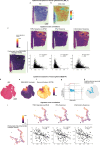Glioma-neuronal circuit remodeling induces regional immunosuppression
- PMID: 40404658
- PMCID: PMC12098748
- DOI: 10.1038/s41467-025-60074-z
Glioma-neuronal circuit remodeling induces regional immunosuppression
Abstract
Neuronal activity-driven mechanisms influence glioblastoma cell proliferation and invasion, while glioblastoma remodels neuronal circuits. Although a subpopulation of malignant cells enhances neuronal connectivity, their impact on the immune system remains unclear. Here, we show that glioblastoma regions with enhanced neuronal connectivity exhibit regional immunosuppression, characterized by distinct immune cell compositions and the enrichment of anti-inflammatory tumor-associated macrophages (TAMs). In preclinical models, knockout of Thrombospondin-1 (TSP1/Thbs1) in glioblastoma cells suppresses synaptogenesis and glutamatergic neuronal hyperexcitability. Furthermore, TSP1 knockout restores antigen presentation-related genes, promotes the infiltration of pro-inflammatory TAMs and CD8 + T-cells in the tumor, and alleviates TAM-mediated T-cell suppression. Pharmacological inhibition of glutamatergic signaling also shifts TAMs toward a less immunosuppressive state, prolongs survival in mice, and shows the potential to enhance the efficacy of immune cell-based therapy. These findings confirm that glioma-neuronal circuit remodeling is strongly linked with regional immunosuppression and suggest that targeting glioma-neuron-immune crosstalk could provide avenues for immunotherapy.
© 2025. The Author(s).
Conflict of interest statement
Competing interests: The authors declare no competing interests.
Figures





Update of
-
Glioma-neuronal circuit remodeling induces regional immunosuppression.bioRxiv [Preprint]. 2023 Aug 6:2023.08.04.548295. doi: 10.1101/2023.08.04.548295. bioRxiv. 2023. Update in: Nat Commun. 2025 May 22;16(1):4770. doi: 10.1038/s41467-025-60074-z. PMID: 37577659 Free PMC article. Updated. Preprint.
References
MeSH terms
Substances
Grants and funding
LinkOut - more resources
Full Text Sources
Medical
Research Materials
Miscellaneous

